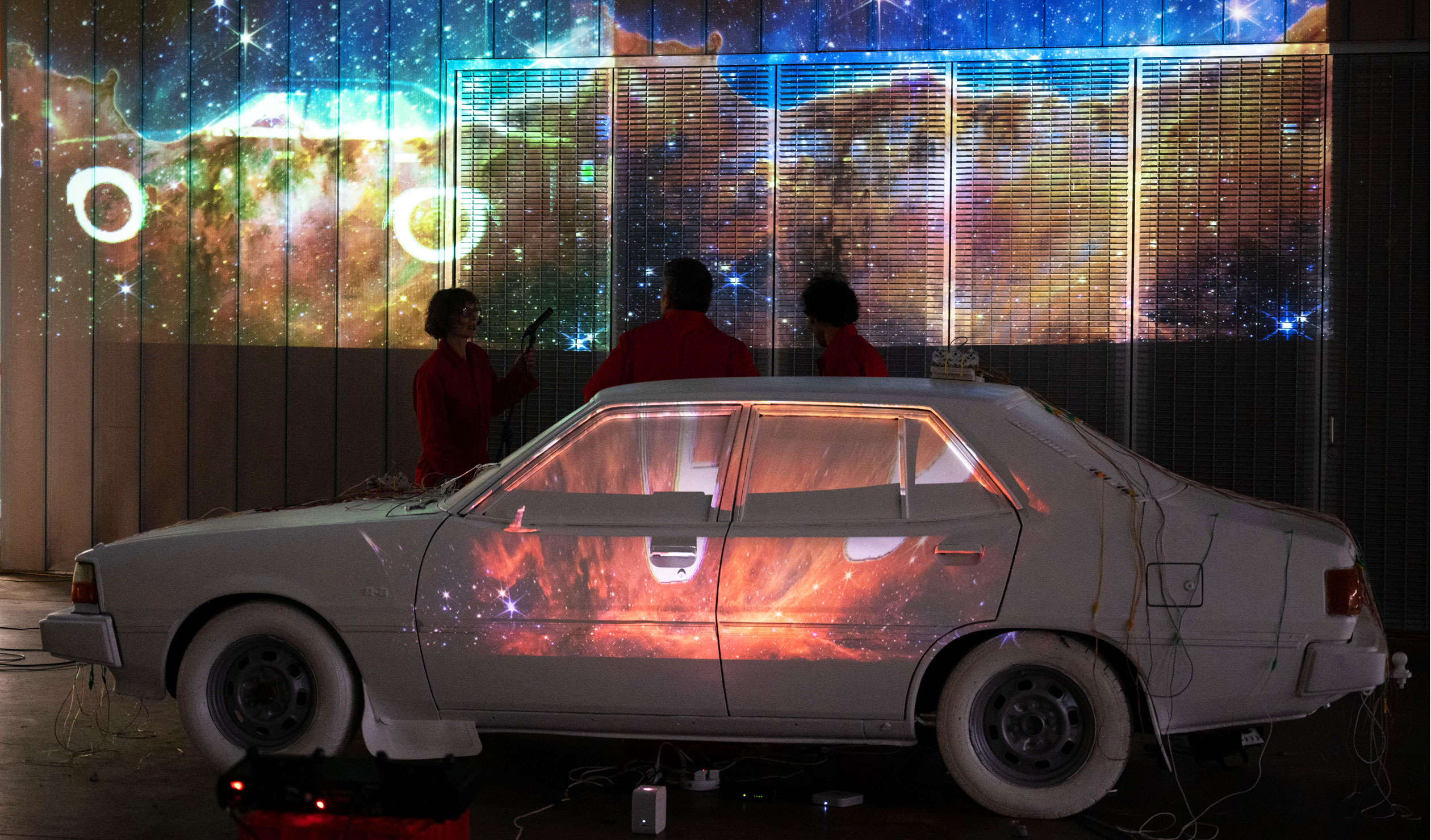Parked on the vast concrete expanse of the Main Assembly Building (MAB) at Tonsley is a 1981 Mitsubishi Sigma. Its body has been painted white, with even the windows and windscreens whited out. The only splashes of color come from the red number plates, printed with MIDIBISHI, and the snaking mass of wiring and speaker cable linking the car to various sound decks and projectors. But what this network of wiring and cables does is simply ingenious. Using MIDI (Musical Instrument Design Interface) sound technology sensors, the body of the vehicle responds to touch, transforming the vintage Sigma from car into musical instrument.
As the light fades, video projections of Mount Fuji and cherry blossoms brighten the wall and play across the car. The Sigma’s exhaust system, now converted into a smoke machine, fogs the stage, creating an ethereal atmosphere.
A performer in white coveralls approaches, playing a Japanese bamboo flute. He joins three comrades in red coveralls around the car, their color scheme matching the triple-bladed red and white logo of Mitsubishi Motors. Traditional music and the sound of crickets meld with an artistic video collage created from historical footage of the famous Japanese motor vehicle manufacturer.
The soundscape accelerates and the performers move between the car and decks, filling the space with a bespoke soundscape of industrial recordings, laser lighting and a fascinating video compilation of historical footage, mechanical plans, performance graphs and vintage media advertising.
The performers shift around the vehicle, playing it like an instrument as they coax their mix of beats and sounds from the car. A row of spanners connected to the front grill by cables and alligator clips is played like a keyboard of factory noise. Hammers, drumsticks, wrenches and slamming doors add a baseline of percussion.

The video projections are mesmerizing. Moving through time, the 45-minute performance carries the audience through the story of Mitsubishi, from its roots in Japan, through the history of car manufacturing at the Tonsley manufacturing site into an imagined future, ending with images of the innovative car-instrument revolving against an astronomical backdrop from the James Webb telescope.
Footage is overlaid and manipulated, psychedelic filters and laser lighting enhancing the soundscape being created in real time by the four performers using recordings they’ve collected from factories and industrial sites across Adelaide. Most visually fascinating is the historical footage from the Tonsley site showing the vast Mitsubishi production lines crowding the expanse of concrete under the audience’s feet. We are whisked through worker-intensive manufacturing into the highly-computerized robotic era, the flow punctuated by the floor siren and paper-bagged lunch.

Get InReview in your inbox – free each Saturday. Local arts and culture – covered.
Thanks for signing up to the InReview newsletter.
The four performers (Emily Collins, Dexter Campos, Eric Bagnara and David Kotlowy) bringing this inspired concept to life are all descendants of workers who supported their families through factory work after arriving in Australia. They bring an impressive range of skills and talents to the project – the four artists collectively possessing decades of experience in both sound and visual art, including music composition and performance, video installation, curating and design.
Project curator Emily Collins says the team came up with the idea of using industrial sounds from around Adelaide as a way of honoring the role of factory work in the troupe’s common history.
MIDIBISHI is an ingenious concept that blends art, nostalgia and technology to create a stunning celebration of both Adelaide’s industrial past, and the specific manufacturing history of the Tonsley site.
The MIDIBISHI sculpture installation is in the Main Assembly Building at Tonsley until August 31 as part of SALA (in parking mode, it broadcasts a series of experimental music soundscapes 24/7). Further live performances are scheduled for August 13 and 27 at 5pm.
Support local arts journalism
Your support will help us continue the important work of InReview in publishing free professional journalism that celebrates, interrogates and amplifies arts and culture in South Australia.
donate here
